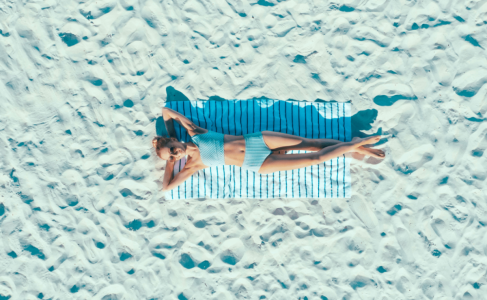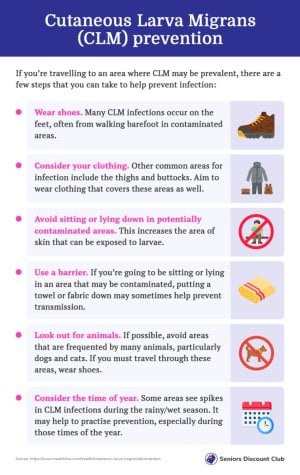The alarming reason why doctors are warning you never to lay on the beach sand without a mat
- Replies 5
Ah, the beach — a place where we often go to unwind, soak up the sun, and bask in the soothing sounds of waves crashing against the shoreline.
But while these sandy havens are a go-to for relaxation and rejuvenation, have you ever considered the potential health risks associated with laying on the sand without some form of barrier?
We certainly hadn't, and that's why we were horrified to learn that doing so could lead to an alarming medical condition known as Cutaneous Larva Migrans (CLM) – all thanks to a little critter called the hookworm.
In a worryingly eye-opening series titled 'New Fear Unlocked', an Australian GP called Dr Samuel recently shared how these microscopic parasites can wreak havoc on your skin if you decide to lounge on the beach without a towel or mat.

He cited the harrowing tale of 17-year-old Michael Dumas, who developed a nightmarish, spider-like skin lesion resulting from an encounter with hookworms.
'He went to the beach with friends, was buried in the sand and then went home. That's when the nightmare started,' Dr Samuel said in a video posted on social media.
'At night, he started to complain of an itch. They initially brushed it off as an ear infection, but then he started to feel more lethargic, and he started to develop rashes, several of these on his buttocks.'
According to the doctor, Michael's deteriorating condition led to the appearance of further rashes across his legs, ultimately resulting in a diagnosis of Cutaneous Larva Migrans (CLM), also known as hookworm infection from dogs.
Thankfully, with the help of anti-parasitic medication, Michael made a full recovery.
Now, you might be wondering: What exactly are hookworms?
These minuscule parasites are commonly found in cats and dogs. President of the Australian Society for Parasitology, Rebecca Traub, states that they are 'the most common feline and canine parasite in Australia', with up to 50 to 100 per cent of these animals infected in northern parts of the country.
Hookworm infection can occur when exposed skin comes into contact with soil or sand contaminated by dog and cat faeces - hence the importance of beachgoers laying on a towel or mat!
The particularly aggressive Ancylostoma Braziliense hookworm is responsible for the most severe cases of CLM.
'It appears like these raised reddened serpent-like lesions that follow the path of the worm migrating through the skin. It's very itchy. These lesions can last for weeks to months, some for years if untreated,' said Professor Traub.
'They require medical attention. They are mainly restricted to the far north tropics but very common in Southeast Asia, the Caribbean, and the southern United States.'
Doctor Heba Jibreal, an Associate Lecturer with the University of Queensland whose areas of special interest include medical dermatology and paediatric dermatology, explained that this is a 'classic case for dermatologists', which is usually fixed with a 'spot treatment' or antiparasitic tablets. However, preventative measures are always the better option.
Dr Jibreal suggests travellers, particularly those visiting tropical countries, be cautious and take necessary precautions like wearing thongs or other footwear when on the beach, using a beach blanket/thick towel so you’re not lying directly on the sand, or using a beach chair.
In an effort to prevent the spread of hookworms, Australian beach authorities often place signs encouraging dog and cat restrictions in the area. Despite these measures, most cases of CLM in Australia are diagnosed in overseas travellers, often returning from places like Bali.

Travellers should be aware of various parasitic infections besides hookworms when travelling. These infections can be caused by different parasites and have different symptoms. For instance, scabies, a skin parasite, leads to itchy red bumps, while giardia, a stomach parasite, can cause abdominal pain and diarrhoea.
Other parasites like whipworms and threadworms can also cause digestive symptoms and are commonly found on or near beaches. Malaria, a blood infection caused by parasites, is a serious concern in regions where the disease is prevalent and can be fatal if not treated.
Fungal infections like Athlete's Foot can be contracted through contact with infected surfaces and cause itching and skin peeling.
To protect against these parasitic infections, travellers should take precautions. These include wearing shoes while walking on sand, avoiding potentially contaminated water, and maintaining regular hand hygiene.
Taking preventive medication, particularly for malaria, is also advisable, and consulting a doctor before international trips is recommended to receive appropriate guidance and medications.
So, fellow beach lovers, heed the warnings of these wise medical professionals to avoid any unwelcome encounters with hookworms or other parasites. Enjoy the sunshine, salty air, and beautiful landscapes, but please, don't forget to pack that all-important towel or beach mat!
What are your thoughts on this? Have you ever experienced a parasite infection before? If so, where did you get it? Additionally, do you have any other advice or words of wisdom for fellow travellers? Please feel free to share your insights in the comments below!
But while these sandy havens are a go-to for relaxation and rejuvenation, have you ever considered the potential health risks associated with laying on the sand without some form of barrier?
We certainly hadn't, and that's why we were horrified to learn that doing so could lead to an alarming medical condition known as Cutaneous Larva Migrans (CLM) – all thanks to a little critter called the hookworm.
In a worryingly eye-opening series titled 'New Fear Unlocked', an Australian GP called Dr Samuel recently shared how these microscopic parasites can wreak havoc on your skin if you decide to lounge on the beach without a towel or mat.

A doctor shared a startling warning about what could be lurking in the beach sand. Credit: Unsplash/Daunation.
He cited the harrowing tale of 17-year-old Michael Dumas, who developed a nightmarish, spider-like skin lesion resulting from an encounter with hookworms.
'He went to the beach with friends, was buried in the sand and then went home. That's when the nightmare started,' Dr Samuel said in a video posted on social media.
'At night, he started to complain of an itch. They initially brushed it off as an ear infection, but then he started to feel more lethargic, and he started to develop rashes, several of these on his buttocks.'
According to the doctor, Michael's deteriorating condition led to the appearance of further rashes across his legs, ultimately resulting in a diagnosis of Cutaneous Larva Migrans (CLM), also known as hookworm infection from dogs.
Thankfully, with the help of anti-parasitic medication, Michael made a full recovery.
Now, you might be wondering: What exactly are hookworms?
These minuscule parasites are commonly found in cats and dogs. President of the Australian Society for Parasitology, Rebecca Traub, states that they are 'the most common feline and canine parasite in Australia', with up to 50 to 100 per cent of these animals infected in northern parts of the country.
Hookworm infection can occur when exposed skin comes into contact with soil or sand contaminated by dog and cat faeces - hence the importance of beachgoers laying on a towel or mat!
The particularly aggressive Ancylostoma Braziliense hookworm is responsible for the most severe cases of CLM.
'It appears like these raised reddened serpent-like lesions that follow the path of the worm migrating through the skin. It's very itchy. These lesions can last for weeks to months, some for years if untreated,' said Professor Traub.
'They require medical attention. They are mainly restricted to the far north tropics but very common in Southeast Asia, the Caribbean, and the southern United States.'
Doctor Heba Jibreal, an Associate Lecturer with the University of Queensland whose areas of special interest include medical dermatology and paediatric dermatology, explained that this is a 'classic case for dermatologists', which is usually fixed with a 'spot treatment' or antiparasitic tablets. However, preventative measures are always the better option.
Dr Jibreal suggests travellers, particularly those visiting tropical countries, be cautious and take necessary precautions like wearing thongs or other footwear when on the beach, using a beach blanket/thick towel so you’re not lying directly on the sand, or using a beach chair.
In an effort to prevent the spread of hookworms, Australian beach authorities often place signs encouraging dog and cat restrictions in the area. Despite these measures, most cases of CLM in Australia are diagnosed in overseas travellers, often returning from places like Bali.
Key Takeaways
- A doctor warns people not to lay on the beach without a towel due to a medical condition called Cutaneous Larva Migrans (CLM), caused by hookworms burrowing in the skin.
- The condition creates raised, reddened lesions on the skin that are very itchy and require medical attention.
- To prevent exposure to hookworms, people should wear footwear, use a beach blanket or chair, and inform health practitioners of their beach activities or overseas travel if they experience any symptoms.
Travellers should be aware of various parasitic infections besides hookworms when travelling. These infections can be caused by different parasites and have different symptoms. For instance, scabies, a skin parasite, leads to itchy red bumps, while giardia, a stomach parasite, can cause abdominal pain and diarrhoea.
Other parasites like whipworms and threadworms can also cause digestive symptoms and are commonly found on or near beaches. Malaria, a blood infection caused by parasites, is a serious concern in regions where the disease is prevalent and can be fatal if not treated.
Fungal infections like Athlete's Foot can be contracted through contact with infected surfaces and cause itching and skin peeling.
To protect against these parasitic infections, travellers should take precautions. These include wearing shoes while walking on sand, avoiding potentially contaminated water, and maintaining regular hand hygiene.
Taking preventive medication, particularly for malaria, is also advisable, and consulting a doctor before international trips is recommended to receive appropriate guidance and medications.
So, fellow beach lovers, heed the warnings of these wise medical professionals to avoid any unwelcome encounters with hookworms or other parasites. Enjoy the sunshine, salty air, and beautiful landscapes, but please, don't forget to pack that all-important towel or beach mat!
What are your thoughts on this? Have you ever experienced a parasite infection before? If so, where did you get it? Additionally, do you have any other advice or words of wisdom for fellow travellers? Please feel free to share your insights in the comments below!









